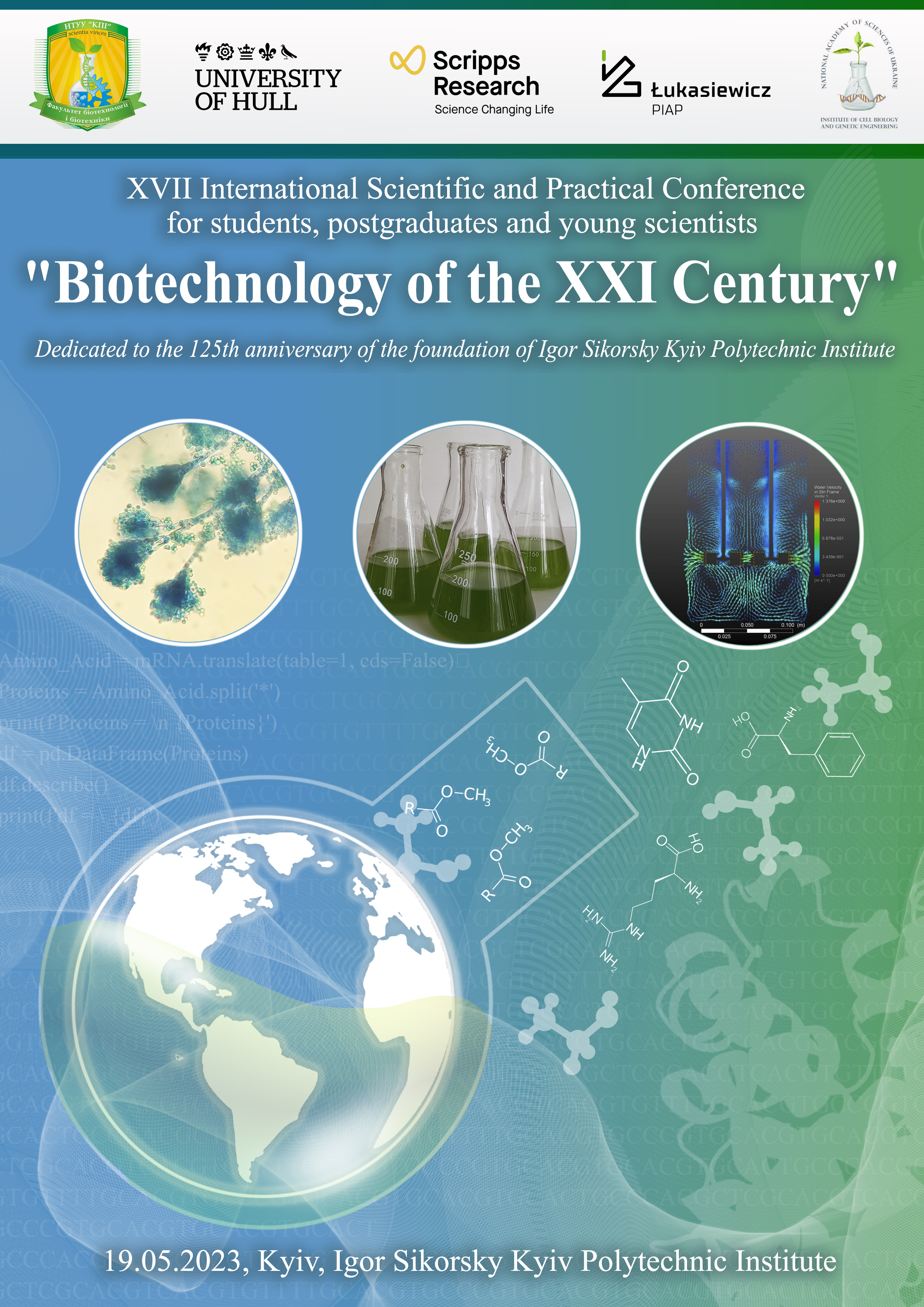ОБҐРУНТУВАННЯ ЗАСТОСУВАНННЯ BACILLUS THURINGIENSIS VAR KURSTAKI ДЛЯ СТВОРЕННЯ БІОІНСЕКТИЦИДУ
Анотація
На сьогодні різноманітні шкідники рослин є великою загрозою для сільського господарства. Сільськогосподарським культурам у всьому світі завдають шкоди понад 10 000 видів комах, які спричиняють орієнтовні щорічні втрати сільськогосподарського виробництва на 11 %. Найчисельнішими видами серед шкідників є представники ряду лускокрилих, зокрема родини совок, частота виявлення яких становила 75%. Упродовж довгого часу для боротьби з шкідниками використовують синтетичні пестициди. Тривале застосування таких пестицидів сприяє розвитку стійкості до них. Так, більше 500 видів членистоногих шкідників набули резистентності до одного чи кількох інсектицидів, а стійкі до гербіцидів бур’яни нараховують близько 200 видів.
Посилання
Vimala Devi, P.S., Duraimurugan, P., Chandrika, K.S.V.P.,et al. Nanobiopesticides for Crop Protection. In: Nanobiotechnology Applications in Plant Protection. Abd-Elsalam, K.A. and Prasad, R. (Eds.), Volume 2, Springer Nature, Switzerland. 2019, 145-168.
Chykhrai, A. V., & Mostoviak, S. M. Lepidipteran pests of soybean in the conditions of the Right-Bank Forest-Steppe of Ukraine. Bulletin of Poltava State Agrarian Academy.2022, 62–68.
Sabarwal, A., Kumar, K., and Singh, R. P. Hazardous effects of chemical pesticides on human health–cancer and other associated disorders. Environ. Toxicol. Pharmacol. 2018, 103–114.
Hashimi, M. H., Hashimi, R., and Ryan, Q. Toxic effects of pesticides on humans, plants, animals, pollinators and beneficial organisms. 2020, 37–47.
Ali, S., Ullah, M. I., Sajjad, A., Shakeel, Q., and Hussain, A. “Environmental and health effects of pesticide residues” in Sustainable Agriculture Reviews. eds. Inamuddin, M. I. Ahamed and E. Lichtfouse (New York, NY: Springer). 2021, 311–336.
Kumar, J., Ramlal, A., Mallick, D., et al. An overview of some biopesticides and their importance in plant protection for commercial acceptance. Plan. Theory 10:1185. 2021
Rosas-García N.M. Biopesticide production from Bacillus thuringiensis: an environmentally friendly alternative, Recent Pat. Biotechnol. 2009, 28–36
Pole A, Srivastava A, Zakeel M.C.M, et al. Role of microbial biotechnology for strain improvement for agricultural sustainability. Editor(s): Ravindra Soni, Deep Chandra Suyal, Ajar Nath Yadav, Reeta Goel, In Developments in Applied Microbiology and Biotechnology, Trends of Applied Microbiology for Sustainable Economy, Academic Press, 2022, 285-317
Ruiu, L. Microbial biopesticides in agroecosystems. Agronomy 8:235, 2018
Bishop, A. H., & Robinson, C. V. Bacillus thuringiensisHD-1 Cry−: development of a safe, non-insecticidal simulant forBacillus anthracis. Journal of Applied Microbiology, 117(3).2014, 654–662.
Roh J. l., Choi J. Y, Li M.S.,et al. Bacillus thuringiensis as a specific, safe, and effective tool for insect pest control. 2007 Apr;17(4):547-59.
Iriarte J, Caballero P. Biología y ecología de Bacillus thuringiensis. Bioinsecticidas: Fundamentos y Aplicaciones de Bacillus thuringiensis en el Control Integrado de Plagas. Caballero P, Ferré J, Eds. Phytoma-España 2001, 15-44.
Jouzani, G. S., Valijanian, E., & Sharafi, R. Bacillus thuringiensis: a successful insecticide with new environmental features and tidings. Applied Microbiology and iotechnology.2017, 2691–2711.
Li, M. S., Je, Y. H., Lee, I. H.. Isolation and Characterization of a Strain of Bacillus thuringiensis ssp. kurstaki Containing a New δ-Endotoxin Gene. Current Microbiology, 45(4). 2002, 299–302.
Anastassiadou M, Arena M, Auteri D, et al. Peer review of the pesticide risk assessment of the active substance Bacillus thuringiensis ssp. aizawai strain GC-91. EFSA J. 2020, 5;18(11):e06293..
Melo AL, Soccol VT, Soccol CR. Bacillus thuringiensis: Mechanism of action, resistance, and new applications: A review. Critical Reviews in Biotechnology. 2016 ;36:317-326

